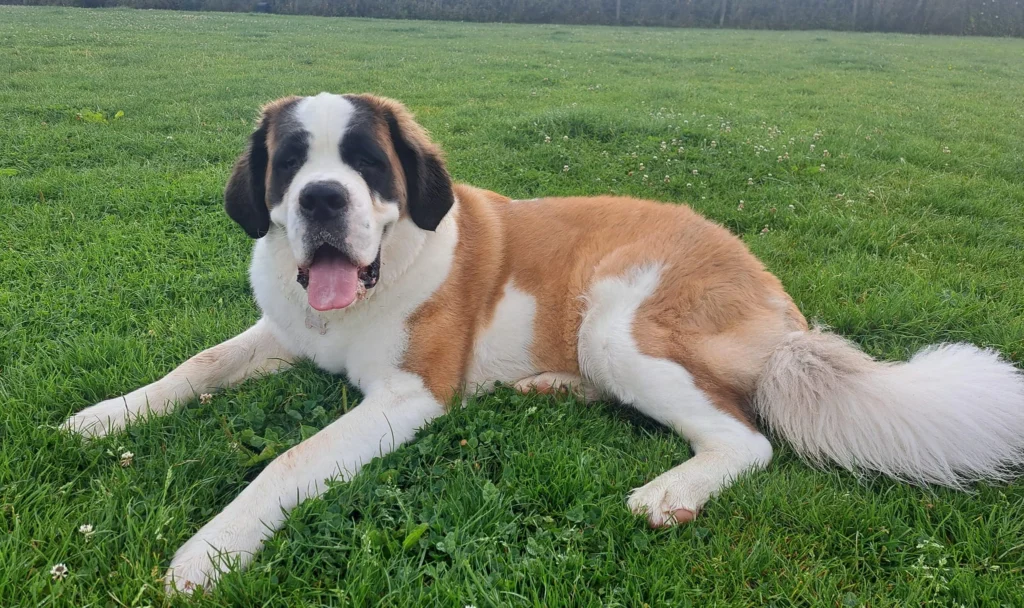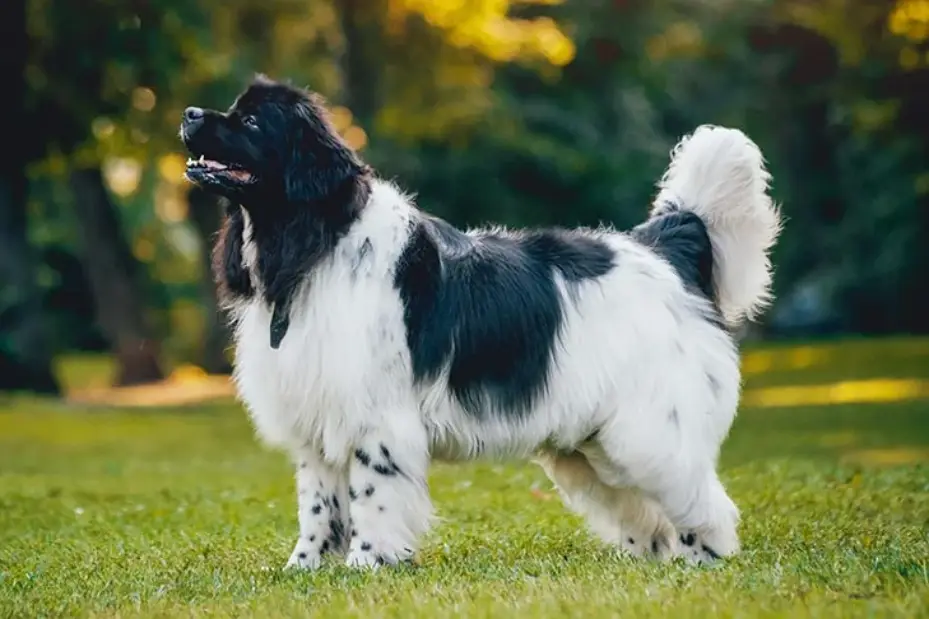Table of Contents
🐶 Saint Bernard Dog Breed: A Gentle Giant with a Noble History
The St. Bernard is one of the most iconic dog breeds in the world, known for its impressive size, gentle demeanor, and storied history. These dogs are not just large in size but also in heart, making them a beloved companion for many dog owners. Often associated with snowy Alpine rescues, the St. Bernard has a reputation for being both a hero and a family-friendly pet. In this article, we’ll explore what makes the St. Bernard such a unique and popular breed, covering everything from its history to its suitability as a family pet.
📜 Short History
The St. Bernard breed traces its origins to the Swiss Alps, specifically the Great St. Bernard Pass, a treacherous route between Switzerland and Italy. The breed was developed by monks at the hospice located in this pass, around the 17th century. The dogs were bred for their strength, endurance, and keen sense of direction, which made them invaluable in rescuing travelers lost in the snow.
Interestingly, the St. Bernard as we know it today is a result of selective breeding. Initially, the breed was smaller and short-haired, better suited for the snowy conditions. However, after a particularly harsh winter in the early 19th century decimated the population, the monks crossbred the remaining dogs with Newfoundland dogs, leading to the larger, long-haired variety seen today.
One of the most famous St. Bernards was a dog named Barry, who lived at the monastery in the early 1800s. Barry is credited with saving over 40 lives, cementing the breed’s reputation as a lifesaver and a loyal companion.
📌 Quick Facts & Essential Details

| Category 🏷️ | Details 📖 |
|---|---|
| 🐶 Breed Name | Saint Bernard |
| 📛 Other Names | St. Bernard, Alpine Mastiff |
| 📍 Origin | Switzerland |
| 🏆 Recognized By | AKC, FCI, UKC, CKC |
| 📏 Size Variants | Standard (No toy or miniature versions) |
| ⚖️ Weight Range | 120 – 180 lbs (54 – 82 kg) |
| 📐 Height Range | 26 – 30 inches (66 – 76 cm) |
| 🎂 Lifespan | 8 – 10 years |
🐕🦺 Coat & Appearance
| Category 🏷️ | Details 📖 |
|---|---|
| 🧥 Coat Type | Thick, dense, available in both short and long-haired varieties |
| 🎨 Coat Colors | Red & White, Brown & White, Brindle & White, Mahogany & White |
⚡ Energy & Personality

| Category 🏷️ | Details 📖 |
|---|---|
| 🔋 Energy Level | Moderate – Requires daily walks but enjoys lounging |
| 🏅 Breed Group | Working Group |
| 🐾 Temperament | Gentle, Loyal, Affectionate, Protective |
| 🏡 Apartment-Friendly? | No – Needs space due to large size |
| 🎓 Trainability | High – Intelligent but requires patience |
🏥 Health & Care Needs

| Category 🏷️ | Details 📖 |
|---|---|
| 💉 Common Health Issues | Hip Dysplasia, Heart Disease, Bloat, Epilepsy |
| 🛁 Grooming Needs | Moderate – Regular brushing and occasional baths |
| 🍂 Shedding Level | High – Seasonal shedding |
| 🏃 Exercise Needs | Moderate – Daily walks and light activity recommended |
🏡 Suitability & Compatibility

| Category 🏷️ | Details 📖 |
|---|---|
| 🏠 Best For | Families, Large Homes, Cold Climates |
| 🚫 Not Ideal For | Apartment Living, Warm Climates |
| 🔊 Barking Level | Low – Generally quiet but will alert |
| 👶 Good With Kids? | Yes – Very gentle and protective |
| 🐕 Good With Pets? | Yes – Friendly with other animals |
| 👩🏫 First-Time Owner Friendly? | Yes – But requires patience and space |
| 🌡️ Weather Tolerance | Excellent in cold weather, struggles in heat |
🎉 Fun & Extra Info
| Category 🏷️ | Details 📖 |
|---|---|
| 🌟 Famous Dogs of This Breed | Barry – A St. Bernard who saved over 40 lives in the Swiss Alps |
| 🧠 Intelligence Level | High – Quick learners with a gentle nature |
| 🐕 Common Behavioral Issues | Drooling, Stubbornness, Overexcitement |
| 🥩 Best Diet | High-quality large-breed kibble with lean meats |
| 🚫 Foods to Avoid | Chocolate, Grapes, Onions, Garlic, High-Fat Foods |
| 🎈 Fun Fact | The St. Bernard’s legendary barrel collar is a myth, but they were trained to carry supplies for rescuers! |
| 💰 Price of Puppy | $1,500 – $3,500 (Depending on breeder & lineage) |
✅ Final Thoughts
The St. Bernard is a gentle giant known for its loyal, affectionate, and protective nature. Originally bred as a rescue dog in the Alps, they now make wonderful family pets. With their gentle demeanor and intelligence, they thrive in spacious homes and cold climates. If you’re looking for a calm, loving, and protective companion, the St. Bernard could be the perfect choice! 🏡🐶
📊 Comparison of Similar Dog Breeds
🐶 St. Bernard vs. Newfoundland 🏔️🌊


| Feature 🏆 | Saint Bernard 🏔️ | Newfoundland 🌊 |
|---|---|---|
| 📍 Origin | Switzerland & Italy | Canada (Newfoundland) |
| 🏅 Recognized By | AKC, FCI, UKC | AKC, FCI, UKC |
| 📏 Size Variants | Giant | Giant |
| ⚖️ Weight Range | 120-180 lbs (54-82 kg) | 100-150 lbs (45-68 kg) |
| 📏 Height Range | 26-30 inches (66-76 cm) | 26-28 inches (66-71 cm) |
| ⏳ Lifespan | 8-10 years | 9-12 years |
| 🐶 Coat Type | Thick, dense, short or long | Thick, water-resistant, double coat |
| 🎨 Coat Colors | Red & white, brown & white, brindle | Black, brown, gray, black & white (Landseer) |
| ⚡ Energy Level | Moderate | Moderate |
| 🏡 Breed Group | Working Group | Working Group |
| 🔊 Barking Level | Moderate | Low to Moderate |
| 👶 Good With Kids? | Yes, very gentle & patient | Yes, very affectionate & protective |
| 🐕 Good With Pets? | Yes, great with other animals | Yes, great with other animals |
| 🧠 Intelligence Level | High (Trainable & Responsive) | Very High (Quick Learner) |
| ⚠️ Common Behavioral Issues | Prone to drooling, can be stubborn | Can be strong-willed, requires mental stimulation |
| 💰 Price of Puppy | $1,500 – $3,500 | $1,500 – $3,500 |
| Overall Rating | ⭐⭐⭐⭐⭐ (Gentle Giant & Loyal) | ⭐⭐⭐⭐⭐ (Intelligent & Loving) |
Conclusion
The St. Bernard is a breed that combines strength, gentleness, and loyalty in a giant, furry package. Whether you’re drawn to their history as rescue dogs or their reputation as gentle family companions, St. Bernards offer a lot of love and companionship to the right owners. However, potential owners should be prepared for the responsibilities that come with caring for such a large dog, including their grooming needs, exercise requirements, and potential health issues.
If you’re considering adding a St. Bernard to your family, take the time to research and understand the breed’s needs. Their size and drooling might be a challenge, but their loving nature makes it all worthwhile. Explore more about this amazing breed and see if it might be the perfect addition to your household.
FAQ
Is the St. Bernard a dangerous dog?
No, St. Bernards are not typically dangerous. They are known for their gentle and friendly nature. However, due to their large size, it’s important to train and socialize them properly to ensure they are well-behaved. Like any large breed, they need responsible handling to prevent any accidental harm.
Is the St. Bernard the best guard dog to protect my family?
While St. Bernards are protective of their families, they are not typically used as guard dogs. They are more likely to be gentle giants rather than aggressive protectors. If you’re looking for a dog that can serve as both a family pet and a guard dog, you might consider breeds known for their guarding instincts, like the Great Pyrenees or the Rottweiler.


